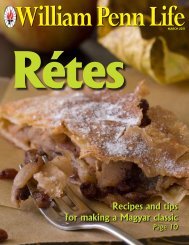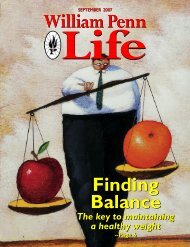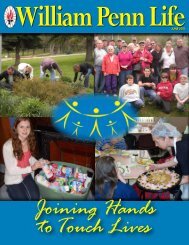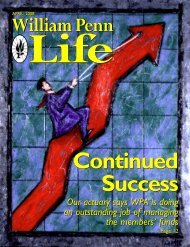November 2009 - William Penn Life
November 2009 - William Penn Life
November 2009 - William Penn Life
Create successful ePaper yourself
Turn your PDF publications into a flip-book with our unique Google optimized e-Paper software.
The Hungarian KitchenTM<br />
with Foszakács Béla<br />
Pumpkins & Gourds<br />
``<br />
FÁRADJON BE A MAGYAR<br />
KONYHÁBA.<br />
Fall and New England go together<br />
like a hand in a glove. Leaves turning<br />
color signals another season<br />
we are about to enter.<br />
The many choices we have<br />
for fresh produce this time of the<br />
year are rewarding as well as<br />
tasty. I will also say that while<br />
New England stands out for me<br />
because I live in New Hampshire,<br />
the northeast corner of our great<br />
country has much to offer in the way<br />
of sustainable foods. In our corner<br />
of the country, we can enjoy many<br />
varieties of apples, stone fruits,<br />
cranberries, vegetables and seasonal<br />
items.<br />
One such great seasonal item<br />
is the squash, and this month<br />
we’ll learn more about them.<br />
Here is your trivia question for the<br />
month: Where is the only place in the world<br />
you can’t grow pumpkins The answer waits in<br />
the oven!<br />
Squash is the edible portion of the gourd family which<br />
is native to North and South America. More than 5,000<br />
years ago in Mexico, squash was eaten by the natives.<br />
There are two types of squash we can enjoy in our diets.<br />
Both kinds contain vitamins A and C, along with niacin,<br />
riboflavin and iron.<br />
Summer squash has thin, edible skins, soft seeds and a<br />
tender flesh with high moisture content and mild flavor.<br />
This type of squash can be prepared using short cooking<br />
times. The most popular varieties of summer squash are<br />
crookneck, patty pan and zucchini.<br />
Winter squash has a thicker skin and heavy seeds<br />
with a very firm flesh. This squash must be peeled as<br />
you cannot eat the skin. The cooking time for winter<br />
squash is longer because the flesh is much thicker. The<br />
most popular of the winter variety are acorn, buttercup,<br />
butternut, Hubbard, spaghetti and turban.<br />
Another edible part of the gourd family--which<br />
includes muskmelon and watermelon--is the pumpkin.<br />
The flesh of the pumpkin is mildly sweet, and the seeds,<br />
when roasted, have a nutty flavor.<br />
The pumpkin was brought to Europe by explorers,<br />
such as Columbus, who came to the new world and<br />
then returned with the orange treasure. About 80<br />
percent of all pumpkins grown are harvested in<br />
October.<br />
In colonial times the pumpkin was used as<br />
an ingredient in making pie crust and not the<br />
actual pie filling. Back then, bakers made<br />
a crust using about a pound or less<br />
of fresh pumpkin chopped small,<br />
combined with thyme, parsley,<br />
sweet marjoram, rosemary,<br />
eggs, cinnamon, clove,<br />
nutmeg, salt and pepper. The<br />
mixture was fried then<br />
shaped into a pie crust.<br />
When it cooled, the pie was<br />
filled with apples and<br />
currants. After that, a mixture<br />
of butter, egg yolks and some<br />
sweet white wine was poured into<br />
the pie shell which gave it body.The<br />
pie was then sliced and served.<br />
The first pumpkin pies were not pies at all. A<br />
small, hollowed-out pumpkin was filled with sweet<br />
creamery milk, spices, molasses, brown sugar and<br />
butter. The pumpkin was then baked on the hot coals of<br />
the fireplace until it was cooked. The inside was thick<br />
like a soup and contained bits of the pumpkin flesh.<br />
Historians note that this was a favorite of George<br />
Washington.<br />
Amelia Simmons in 1796 had a recipe for pumpkin<br />
pudding in a crust in her American cookbook. This<br />
recipe is what we enjoy every Thanksgiving Day.<br />
And now you know a little bit more about this orange<br />
member of the gourd family. Enjoy the recipes and have<br />
a wonderful Thanksgiving. Chef Vilmos and I wish you<br />
all the very best.<br />
Trivia answer: The only place in the world you can’t<br />
grow a pumpkin is on the continent of Antarctica.<br />
Jó étvágyat<br />
Foszakács Béla<br />
`<br />
“The Hungarian Kitchen”<br />
is a trademark of <strong>William</strong> S. Vasvary.<br />
14 10 <strong>William</strong> <strong>Penn</strong> <strong>Life</strong>, <strong>November</strong> <strong>2009</strong>

















